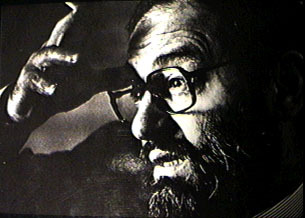
|
Umberto Eco(1932—) President of the Scuola Superiore di Studi Umanistici, University of BolognaItalian synthetic modernist whose work underpins many of the theories about what is real ?, and what is original?Pseudonym: Dedalus |
| Author's home page: Porta Ludovica |
| Homepages, texts online, etc: Robert Daeley's “Bohemian Ink” web site |
| Biography by Petri Liukkonen |
| Travels in Hyperreality |
“I think of the postmodern attitude as that of a man who loves a very cultivated woman and who knows he cannot say to her, I love you madly, because he knows that she knows (and she knows that he knows) that these words have already been written by Barbara Cartland. Still, there is a solution. He can say, “As Barbara Cartland would put it, I love you madly.” At this point, having avoided false innocence, having said clearly that it is no longer possible to speak innocently, he will nevertheless have said what he wants to say to the woman: that he loves her, but he loves her in an age of lost innocence. If the woman goes along with this, she will have received a declaration of love all the same. Neither of the two speakers will feel innocent, both will have accepted the challenge of the past, of the already said, which cannot be eliminated; both will consciously and with pleasure play the game of irony . . . But both will have succeeded, once again, in speaking of love.” (Postscript to The Name of the Rose)
“Gentlemen, I will now show you this text. Forgive me for using a photocopy. It's not distrust. I don't want to subject the original to further wear.” “But Ingolf's copy wasn't the original,” I said.“The parchment was the original.” “Casubon, when originals no longer exist, the last copy is the original.” (Foucault's Pendulum)
“I have come to believe that the whole world is an enigma, a harmless enigma that is made terrible by our own mad attempt to interpret it as though it had an underlying truth.” (Umberto Eco)
“I felt like poisoning a monk.”
Umberto Eco, on why he wrote the novel. "The Name of the Rose."
“The real hero is always a hero by mistake; he dreams of being an
honest coward like everybody else.”
(Travels in Hyperreality)
“Idiot. Above her head was the only stable place in the cosmos, the only refuge from the damnation of the panta rei, and she guessed it was the Pendulum's business, not hers. A moment later the couple went off—he, trained on some textbook that had blunted his capacity for wonder, she, inert and insensitive to the thrill of the infinite, both oblivious of the awesomeness of their encounter—their first and last encounter—with the One, the Ein-Sof, the Ineffable. How could you fail to kneel down before this altar of certitude?
(Foucault's Pendulum, trans. Wm. Weaver)
"Let us be realistic: there is nothing more meaningful than a text which asserts there is no meaning. If there is something to be interpreted, the interpreter must speak of something which must be found somewhere, and in some way respected."
(The Limits of Interpretation, 7)
Select Bibliography
ed.: The Sign of Three, 1983 (with Thomas A. Sebeok).For further reading